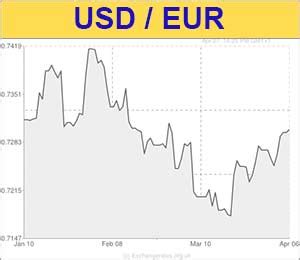Introduction
The Euro (EUR) and the US Dollar (USD) are the world’s two most-traded currencies, accounting for a large proportion of global foreign exchange trading volume. The exchange rate between these two currencies, commonly known as the EUR/USD pair, is closely monitored by investors, businesses, and economists. This article explores the factors influencing the Euro exchange rate to USD, provides forecasts for its future trajectory, and discusses the implications for businesses and investors.

Key Factors Driving the EUR/USD Exchange Rate
The EUR/USD exchange rate is influenced by a complex interplay of economic, political, and global factors, including:
- Economic Indicators: GDP growth, inflation, interest rates, and unemployment rates in the Eurozone and the United States play a significant role in determining the relative attractiveness of the two currencies. Strong economic performance in the Eurozone compared to the US can lead to an appreciation of the euro against the dollar, while weak economic data can have the opposite effect.
- Fiscal and Monetary Policy: Decisions by the European Central Bank (ECB) and the US Federal Reserve (Fed) on interest rates, quantitative easing, and other monetary policy measures can have a major impact on the exchange rate.
- Political Factors: Political stability, fiscal discipline, and economic reforms in the Eurozone and the US can influence investor confidence and affect the demand for these currencies.
- Global Economic Outlook: The global economic environment, including factors such as trade, inflation, and geopolitical events, can affect the demand for both the euro and the dollar.
Historical Trends and Forecasts
The EUR/USD exchange rate has fluctuated over the years, with periods of stability and volatility. In recent years, the euro has generally weakened against the US dollar, due in part to the stronger economic recovery in the US and the ECB’s accommodative monetary policy. According to the European Central Bank (ECB), the Eurozone’s annual GDP growth is projected to be 3.2% in 2023 and 1.8% in 2024, while the International Monetary Fund (IMF) estimates that the US economy will grow by 2.3% in 2023 and 1.2% in 2024.
Forecasts for the EUR/USD exchange rate in 2025 vary among analysts. Some predict a further decline in the euro, citing the ECB’s commitment to keep interest rates low and the ongoing impact of the war in Ukraine on the Eurozone economy. Others see potential for a rebound in the euro if the Eurozone economy recovers more strongly than expected.
Implications for Businesses and Investors
The EUR/USD exchange rate has significant implications for businesses and investors who conduct transactions across borders or invest in different currencies.
- Businesses: Exporters in the Eurozone may benefit from a weaker euro, as it effectively makes their products cheaper for overseas customers. Importers, on the other hand, may face higher costs if the euro weakens.
- Investors: Investors who hold assets in different currencies can experience gains or losses based on exchange rate fluctuations. For example, a US investor with a portfolio of European stocks would benefit from a stronger euro, as it would increase the value of their investment in dollar terms.
Common Mistakes to Avoid
When dealing with the EUR/USD exchange rate, it is important to avoid common mistakes that can lead to financial losses:
- Ignoring Economic Data: Failing to monitor economic indicators and news events that can impact the exchange rate can result in poor decision-making.
- Chasing Trends: Trying to predict short-term fluctuations in the exchange rate can be risky and counterproductive. Focus on long-term trends and avoid making impulsive trades.
- Using Unreliable Sources: Relying on inaccurate or biased information can lead to misguided decisions. Always use credible sources for exchange rate data and forecasts.
Conclusion
The EUR/USD exchange rate is a complex and dynamic indicator of the economic relationship between the Eurozone and the United States. While forecasting the future trajectory of the exchange rate with certainty is challenging, understanding the factors that influence it can help businesses and investors make informed decisions. By carefully considering economic indicators, political factors, and the global economic outlook, businesses and investors can mitigate risks and maximize opportunities related to currency fluctuations.
Additional Insights
- Currency Hedging: Businesses and investors can use currency hedging instruments, such as forward contracts or options, to minimize the impact of exchange rate fluctuations on their financial performance.
- Emerging Markets: The EUR/USD exchange rate can also impact emerging market economies that trade with both the Eurozone and the United States.
- Technology: Technological advancements, such as electronic trading platforms and artificial intelligence, have made it easier for businesses and investors to monitor and manage currency risk.
Tables
| Year | EUR/USD Exchange Rate (Average) |
|---|---|
| 2017 | 1.19 |
| 2018 | 1.22 |
| 2019 | 1.12 |
| 2020 | 1.09 |
| 2021 | 1.22 |
| 2022 | 1.06 |
| Economic Indicator | Eurozone | United States |
|---|---|---|
| GDP Growth (2022) | 3.9% | 2.3% |
| Unemployment Rate (2022) | 6.5% | 3.5% |
| Inflation Rate (2022) | 5.1% | 7.1% |
| Monetary Policy | European Central Bank (ECB) | Federal Reserve (Fed) |
|---|---|---|
| Interest Rate (2022) | 0.25% | 4.00% |
| Quantitative Easing | Ongoing | Tapering |
| Forecast | EUR/USD Exchange Rate | Source |
|---|---|---|
| 2023 | 1.05 | International Monetary Fund (IMF) |
| 2024 | 1.03 | European Central Bank (ECB) |
| 2025 | 0.98 | Bank of America Merrill Lynch |



